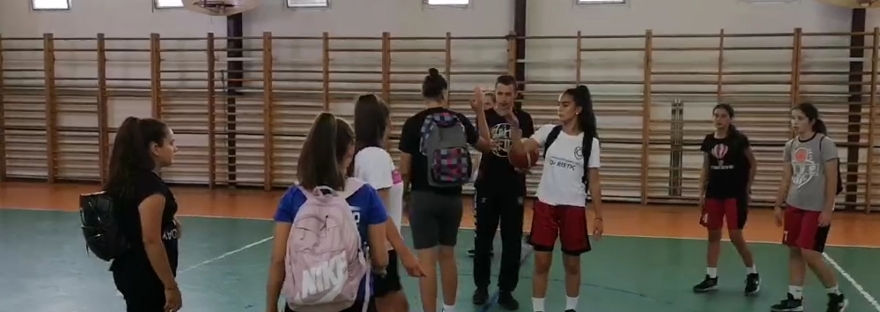Testing of the game “In The Shoes of Others” as a part of the project “Sport tolerance”, was organized in Teslic, Bosnia and Herzegovina on 3rd of September. Testing process was planned and implemented in two forms as follows:
- 1st form of the game had a purpose to develop the feelings towards the people who are coping with the challenge of extra weight or obesity.
- 2nd form of the game focused on developing the feelings towards people with disability of any kind, but in this specific case people with hearing disability.
Event itself was organised in the sports hall of public elementary school “Vuk Karadzic” during the training session of female basketball club “WBS Teslic”. There were 18 players between 12 and 17 years of age together with 3 coaches who took active participation throughout the whole event.
Game “In The Shoes of Others” forms
1st form of the game
We started the 1st form of this game by explaining very simple rules of the game that had to be followed. Main idea of the game was to simulate extra body weight which was done by carrying heavy backpacks while playing the game. After taking heavy backpacks and starting to play a game with it, players were facing a challenge. After only 10 minutes of the game (or 1/4 of the game) players were visibly tired to the extent they were not able to continue playing with added weight. After experiencing such situation, we were able to engage players in discussion on topics such as extra body weight, overweight and/or obesity and all the accompanying issues. Our main focus of the discussion was the idea of tolerance and empathy towards other people, as this gave the players a chance to feel what the people in similar condition would feel and how hard and challenging simple moving can be. We extended our discussion towards sharing their personal experiences by asking the players If they ever had unrealistic expectations from people with extra weight/overweight/obesity condition for example: while playing on the same team during PE class and got annoyed If they failed to meet the expectations. This really gave the players a chance to explore their own level of tolerance, especially after they had a chance to be in the shoes of those people. It made them realise that they were not tolerant in most cases. Main conclusion of our discussion was that the players realised how it’s like to be the person with the issue in question, how hard it and what sort of challenges they face in life but especially in sport activities by their peers.
2nd form of the game
We continued with the 2nd form of the game in the same spirit as the 1st one, and that is by explaining simple rules. This time, our players were forbidden from speaking during the game and in addition, we plugged their ears in order to decrease or diminish their hearing ability. Our main goal was to put the players with that conditions in the game and let them play, and afterwards explain their experience in order to show them how its like to play basketball for the people with speaking and/or hearing disability. The idea was to get them understand what it’s like for people with hearing and/or speech disability to play a game with the communication being disrupted. After playing the game for 10 minutes, we headed for discussion on their impressions. Girls shared their insight on the challenges and difficulties they faced while playing, especially when it comes to paying attention to other players, especially the judge or a demanding coach. There were many situations in which girls didn’t even notice the judge and what he/she was saying or which error was showing – in most cases they would just continue with the game. In addition, while playing girls were not able to spot the available player since the other player couldn’t shout at them. Also, very similar situation happened when it comes to communication with the coach. Our final conclusion on which we all agreed to was that it is very challenging for the people with hearing and/or speaking disability in a sense of the game playing but also getting a judge and setting rules for judging such a game. We all agreed that the level of tolerance for people with speaking and/or hearing disability should be on a much higher level.
As a final conclusion, coming from me as a professor and the coach and the girls who took active participation is that the game „In The Shoes of Others“ has a great potential to change and raise awareness in these two forms, but also to develop more forms of this game.
Vanja Subašić, professor and coach



